Choking Yourself Correctly by Tim Lewis
Right now within the predator hunting community, we are seeing a surge of shotgun hunting stories. Hunting coyotes with a shotgun has grown in popularity over the past couple of years. It has gotten to the point where a higher percentage of shooters prefer this method over the classic rifle hunting and it continues to gain traction everyday. Along with that popularity comes a lot of questions from hunters who may not be familiar with shotguns. Not all of us were brought up shooting waterfowl, quail or rabbits, so shot gunning predators could be a lot of shooters' first introduction to the shotgun world.
One of the most common questions that you will find going around is "What Choke Do I Need for Coyotes?" I have stopped counting how many times I have seen or been asked this question personally, whether during our many seminars, in emails or on the internet. Unfortunately, often times the question gets answered with something like "get the tightest pattern possible" or "just grab an extra full choke and some #4 buck and you'll be good." Being a water fowler and competitive clay shooter first and foremost, I tend to cringe a little when I hear a new shot gunner being told these things.
The purpose of this article is to show you some quick results of patterning with different stock choke tubes supplied with a new Benelli Vinci 12 gauge. Of course other results will vary and won't be exact because every gun and choke is different, but these results are meant to give a basic idea of what is happening with certain chokes and hopefully lead you in the right direction to selecting the correct choke for your hunting situation.
The chokes we will concentrate on are the Cylinder (C), Improved Cylinder (IC), Modified (M), and Full (F). To give some technical info, I will tell you that a 12 gauge bore (cylinder) measures .729" or .730" depending on who you ask. Modified choking is .020" smaller than cylinder, Full is .035" smaller than cylinder and Extra full is considered .040" smaller or more. Of course these numbers do not represent the actual chokes themselves; rather they are actual accepted standard measurements. There are many, many different choke sizes and manufacturers and most of them will differ in what they consider full or modified and even their constriction numbers will differ slightly, but for this discussion we at least have the basics.
In order to make a decision on what choke is needed, the shot gunner must first answer two questions. How long of a shot are you typically going to be taking and how experienced are you with shooting a shotgun, or more specifically, since most of your shots are going to be at moving coyotes, how experienced are you at wing shooting? If you are going to be hunting thick cover and taking shots at 35yds or less than the need for an extra full turkey choke or something like it is not needed and will probably just end up being a handicap, especially for the beginner shooter. If you are hunting more open terrain and you're likely to be presented with shots out to 60yds, then having that full or extra full choke will probably come in handy due to its tighter pattern.
Beginner shooters make the mistake all too often of getting that extra full choke and trying to be proficient with it at close distances. It is hard enough to shoot a running coyote at 15-20 yards with a shotgun, let alone trying to hit one with a pattern the size of an orange or grapefruit. In the picture below you see what the pattern looks like out of our test gun with the Full choke at 10yds on a 5 1/2 " target.
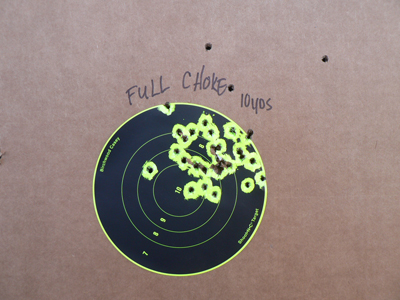
If I was a novice or beginner with a shotgun, I certainly would not want to be shooting that kind of pattern. I would want to give myself every advantage possible to hit my target by casting a bigger net, so to speak. Even with having a great deal of shotgun experience, if I know that I will be hunting an extremely thick area, I myself will opt for a much more open choke like the IC rather than my normal Carlson's .670 or .680, so that I throw a better pattern at short distance.
Now in the next two pictures you will see the difference in the pattern at close range with the C and IC chokes out of our test gun.
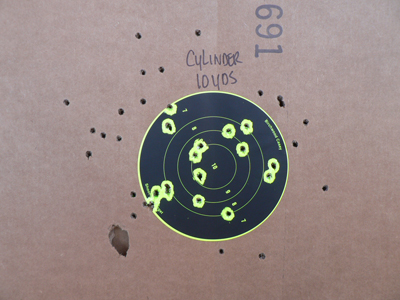
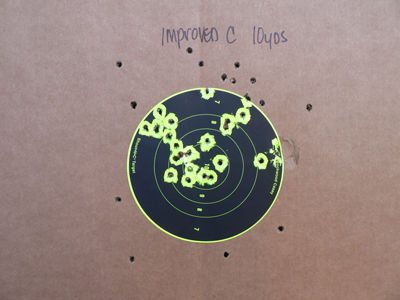
Clearly you can already see the dramatic difference in getting away from the full choke at extremely close ranges and the advantage that having IC or C chokes for those shots will give you. Since I have done some extensive testing other than what is shown here, I will say that it is very hard to beat an IC choke at 20yds with #4 buck or Dead Coyote loads. But just to open things up a bit, I'll show you our test gun's pattern with a modified choke at 20yds. This is probably a more realistic distance in which most of your coyotes or other predators will be taken. Over the years our data has shown that the greatest majority of coyotes take with a shotgun are between 20-30yds.
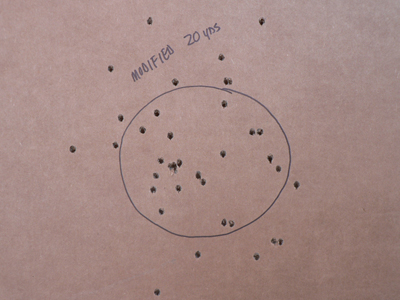
Speaking from experience, the above pattern will hold together nicely and be just as deadly out to 30yds. So the M choke would be a very good choice for anyone who will be presented with an average shot of 15-35 yards.
Once you start getting into more open terrain and extending your shot distances, that's when things get interesting. It's amazing to see what happens to a shot pattern when the distance changes by 20yds. There are a lot of variables that play on what the pattern will turn out like, such as wind, the type of wad used, what ammo manufacturer, what choke manufacturer and so on. The next picture is of a pattern from the same M choke, except it is at 40yds. The difference should be pretty obvious.
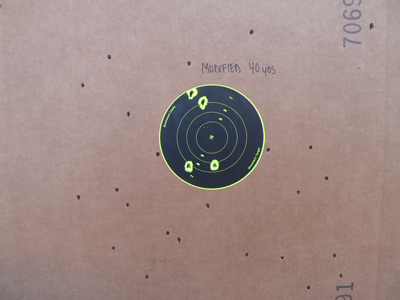
Even though the pattern between the M choke at 20 and 40 yards is quite different, it is still going to be a lethal shot at 40yds. However, at distances past 40yds the M choke will start to open up to the point where you will not be guaranteed a lethal hit on the coyote. Obviously using the full or extra full choke will give you a much tighter pattern at those ranges and beyond. So just from this quick test, I personally would not take a shot at a coyote past 45 yards with anything, but a full or tighter choke.
To solve the problem of choosing the correct choke for any given situation, something that I do regularly is carry a set of chokes while in the field. Much like I used to do while shooting sporting clays, where I would be constantly changing chokes for a particular shot. This is also one of the reasons why I choose to shoot extended chokes in all of my guns. My personal preference is the Carlson's Extended chokes, but there are many on the market to choose from. Extended chokes give you the ability to quickly remove the choke without having to fumble with trying to find a choke wrench or tightening your chokes too much. Extended chokes only need to be hand tightened, but should be checked periodically to make sure they don't come loose.
What I hope for you to gain from this, especially you beginner shooters, is that you will choose the choke that will give you the best pattern to match your shooting ability and ethically kill that predator. Experienced shooters can get away with using an extra full choke for all situations, but if you are not an avid shot gunner than try to keep that pattern a bit more open and your shots within 40 yards. Once you figure out how your shotgun shoots with different chokes, then you will be ready to experience some of the most exciting shooting there is--SHOT GUNNING PREDATORS!
FOXPRO welcomes thoughtful comments from our visitors. All comments are moderated prior to publication. Please review our Comments Policy.